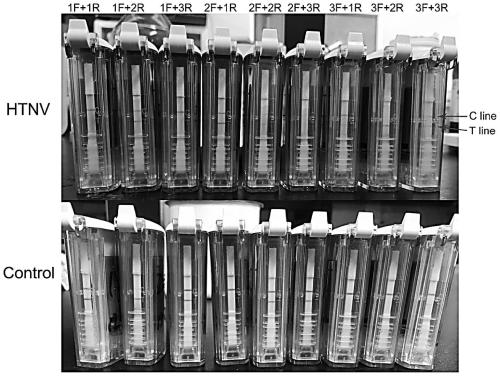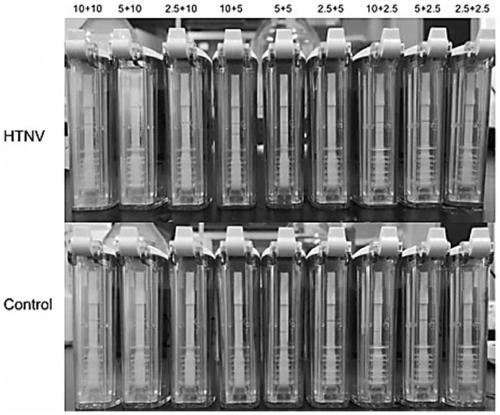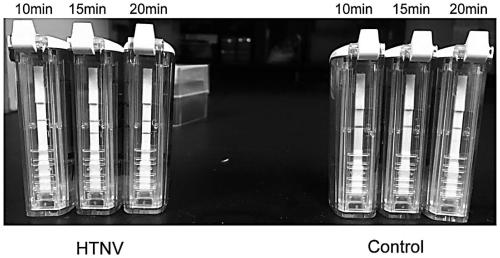Nucleic acid set, kit and detection method for detecting Hantaan viruses through RPA (recombinase polymerase amplification)
A technology of Hantaan virus and a kit, applied in the biological field, can solve the problems of rapid detection of Hantaan virus, inability to separate from price automatic instruments, failure to perform typing, etc., and achieves short detection time, short response time, and simplicity. carry effect
- Summary
- Abstract
- Description
- Claims
- Application Information
AI Technical Summary
Problems solved by technology
Method used
Image
Examples
Embodiment 1
[0053] Embodiment 1, design and screening of Hantaan virus HTNV primers and probes
[0054] (1) Design of primers and probes
[0055] The inventor's laboratory has preserved the positive plasmid standard product (GeneBank: M14626.1) of the S gene of the conservative segment of the Hantaan virus HTNV standard strain 76-118, i.e. the nucleotide sequence shown in SEQ ID NO.1. S gene recombinant plasmid using in vitro transcription kit After Systems-T7 (Promega, the U.S.) was transcribed into RNA in vitro, the concentration was measured using NanoDrop, according to the formula (6.02 × 10 23 copy number / mole)×(concentration ng / μL×10 -9 ) / (RNA length×340)=copies / μL to convert copy number, take 10 5 Copies / μL RNA 1 μL using PrimeScript TM The 1st StrandcDNA Synthesis Kit (Takara, Japan) was used for reverse transcription to obtain cDNA, which was used as a template in the subsequent screening of primers and probes and optimization of the reaction system in Example 1 and Exampl...
Embodiment 2
[0067] Embodiment 2: Optimization of RPA reaction system, amplification and detection conditions
[0068] In the process of primer screening, the disposable nucleic acid detection device is still unstable, so the RPA reaction system, amplification and detection conditions need to be optimized
[0069] (1) Primer probe concentration
[0070] The concentration of the forward primer was kept constant at 10 μM, the concentration of the probe was set to 10 μM, 5 μM, and 2.5 μM, and the concentration gradient of the reverse primer was 10 μM, 5 μM, and 2.5 μM. The reverse primers were combined into 9 groups, the combination numbers are shown in Table 3, and a negative control was set for each group. The 50 μL RPA reaction system and amplification conditions were the same as in Example 1, and the results were interpreted using a disposable nucleic acid detection device. Table 3 Combination numbers of reverse primer concentration and probe concentration.
[0071] Table 3. Probe Concen...
Embodiment 3
[0080] Embodiment 3: Sensitivity evaluation of RPA detection
[0081] With the Hantaan virus HTNV recombinant plasmid mentioned in Example 1, first use the in vitro transcription kit After Systems-T7 (Promega, the U.S.) was transcribed into RNA in vitro, the concentration was measured using NanoDrop, according to the formula (6.02 × 10 23 copy number / mole)×(concentration ng / μL×10 -9 ) / (RNA length×340)=copies / μL conversion copy number, ten-fold dilution to get 10 6 copies / μL, 10 5 copies / μL, 10 4 copies / μL, 10 3 copies / μL, 10 2 Copies / μL, 10copies / μL, 1copies / μL of RNA, take 1μL each and use PrimeScript TM The 1st Strand cDNASynthesis Kit (Takara, Japan) was reverse-transcribed to obtain gradient cDNA, each using 1 μL of cDNA as a template to add the optimal reaction system determined in Example 2, and using the optimal primer combination screened in Example 1 for RPA detection. After mixing, amplify at 37°C for 17.5 minutes, take out the reaction tube at the 4th minut...
PUM
 Login to View More
Login to View More Abstract
Description
Claims
Application Information
 Login to View More
Login to View More - R&D
- Intellectual Property
- Life Sciences
- Materials
- Tech Scout
- Unparalleled Data Quality
- Higher Quality Content
- 60% Fewer Hallucinations
Browse by: Latest US Patents, China's latest patents, Technical Efficacy Thesaurus, Application Domain, Technology Topic, Popular Technical Reports.
© 2025 PatSnap. All rights reserved.Legal|Privacy policy|Modern Slavery Act Transparency Statement|Sitemap|About US| Contact US: help@patsnap.com



